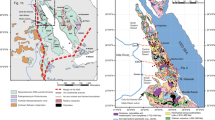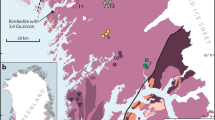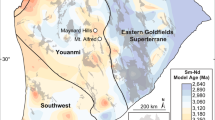Abstract
The continental crust is the principal record of conditions on the Earth during the past 4.4 billion years1,2. However, how the continental crust formed and evolved through time remains highly controversial3,4. In particular, the composition and thickness of juvenile continental crust are unknown. Here we show that Rb/Sr ratios can be used as a proxy for both the silica content and the thickness of the continental crust. We calculate Rb/Sr ratios of the juvenile crust for over 13,000 samples, with Nd model ages ranging from the Hadean to Phanerozoic. The ratios were calculated based on the evolution of Sr isotopes in the period between the TDM Nd model age and the crystallization of the samples analysed. We find that the juvenile crust had a low silica content and was largely mafic in composition during the first 1.5 billion years of Earth’s evolution, consistent with magmatism on a pre-plate tectonics planet. About 3 billion years ago, the Rb/Sr ratios of the juvenile continental crust increased, indicating that the newly formed crust became more silica-rich and probably thicker. This transition is in turn linked to the onset of plate tectonics5 and an increase of continental detritus into the oceans6.
This is a preview of subscription content, access via your institution
Access options
Subscribe to this journal
Receive 12 print issues and online access
$259.00 per year
only $21.58 per issue
Buy this article
- Purchase on Springer Link
- Instant access to full article PDF
Prices may be subject to local taxes which are calculated during checkout



Similar content being viewed by others
References
Wilde, S. A., Valley, J. W., Peck, W. H. & Graham, C. M. Evidence from detrital zircons for the existence of continental crust and oceans on the Earth 4.4 Gyr ago. Nature 409, 175–178 (2001).
Kemp, A. I. S. et al. Hadean crustal evolution revisited: New constraints from Pb–Hf isotope systematics of the Jack Hills zircons. Earth Planet. Sci. Lett. 296, 45–56 (2010).
Hawkesworth, C. J. et al. The generation and evolution of the continental crust. J. Geol. Soc. Lond. 167, 229–248 (2010).
Arndt, N. T. Formation and evolution of the continental crust. Geochem. Perspect. 2, 405–533 (2013).
Shirey, S. B. & Richardson, S. H. Start of the Wilson cycle at 3 Ga shown by diamonds from subcontinental mantle. Science 333, 434–436 (2011).
Pons, M. L. et al. A Zn isotope perspective on the rise of continents. Geobiology 11, 201–214 (2013).
Kemp, A. I. S., Hawkesworth, C. J., Paterson, B. A. & Kinny, P. D. Episodic growth of the Gondwana supercontinent from hafnium and oxygen isotope ratios. Nature 439, 580–583 (2006).
Vervoort, J. D. & Blichert-Toft, J. Evolution of the depleted mantle: Hf isotope evidence from juvenile rocks through time. Geochim. Cosmochim. Acta 63, 533–566 (1999).
Flament, N., Coltice, N. & Rey, P. F. A case for late-Archaean continental emergence from thermal evolution models and hypsometry. Earth Planet. Sci. Lett. 275, 326–336 (2008).
Barker, F. & Arth, J. G. Generation of trondhjemitic-tonalitic liquids and Archean bimodal trondhjemite-basalt suites. Geology 4, 596–600 (1976).
Vervoort, J. D., Fisher, C. M. & Kemp, A. I. S. The myth of a highly heterogeneous Hf-Nd eoarchean mantle and large early crustal volumes. Mineral. Mag. 77, 2409 (2013).
Kelemen, P. B., Hanghøj, K. & Greene, A. R. in Treatise of Geochemistry Vol. 3 (ed Rudnick, R. L.) 593–659 (Elsevier, 2003).
Ellam, R. M. Lithospheric thickness as a control on basalt geochemistry. Geology 20, 153–156 (1992).
Thompson, A. B. & Connolly, J. A. D. Melting of the continental-crust—some thermal and petrological constraints on anatexis in continental collision zones and other tectonic settings. J. Geophys. Res. 100, 15565–15579 (1995).
van Thienen, P., Vlaar, N. J. & van den Berg, A. P. Plate tectonics on the terrestrial planets. Phys. Earth Planet. Inter. 142, 61–74 (2004).
Korenaga, J. in Archean Geodynamics and Environments Vol. 164 (eds Benn, K., Mareschal, J. C. & Condie, K. C.) 7–32 (American Geophysical Union, 2006).
Kamber, B. S. & Collerson, K. D. Role of ‘hidden’ deeply subducted slabs in mantle depletion. Chem. Geol. 166, 241–254 (2000).
Dhuime, B., Hawkesworth, C. J. & Cawood, P. A. When Continents Formed. Science 331, 154–155 (2011).
Arndt, N. T. & Goldstein, S. L. An open boundary between lower continental crust and mantle: Its role in crust formation and crustal recycling. Tectonophysics 161, 201–212 (1989).
Van Kranendonk, M. J. Onset of Plate Tectonics. Science 333, 413–414 (2011).
Belousova, E. A. et al. The growth of the continental crust: Constraints from zircon Hf-isotope data. Lithos 119, 457–466 (2010).
Dhuime, B., Hawkesworth, C. J., Cawood, P. A. & Storey, C. D. A change in the geodynamics of continental growth 3 billion years ago. Science 335, 1334–1336 (2012).
Valley, J. W. et al. 4.4 billion years of crustal maturation: Oxygen isotope ratios of magmatic zircon. Contrib. Mineral. Petrol. 150, 561–580 (2005).
Liu, X. M. & Rudnick, R. L. Constraints on continental crustal mass loss via chemical weathering using lithium and its isotopes. Proc. Natl Acad. Sci. USA 108, 20873–20880 (2011).
Lee, C. T. A. et al. Regulating continent growth and composition by chemical weathering. Proc. Natl Acad. Sci. USA 105, 4981–4986 (2008).
Scholl, D. W. & von Huene, R. in Earth Accretionary Systems in Space and Time Vol. 318 (eds Cawood, P. A. & Kröner, A.) 105–125 (Geological Society, 2009).
Shields, G. A. A normalised seawater strontium isotope curve: Possible implications for Neoproterozoic-Cambrian weathering rates and the further oxygenation of the Earth. eEarth 2, 35–42 (2007).
Canfield, D. E., Habicht, K. S. & Thamdrup, B. The Archean sulfur cycle and the early history of atmospheric oxygen. Science 288, 658–661 (2000).
Cook, P. J. & Shergold, J. H. Phosphorus, phosphorites and skeletal evolution at the Precambrian–Cambrian boundary. Nature 308, 231–236 (1984).
Benitez-Nelson, C. R. The biogeochemical cycling of phosphorus in marine systems. Earth-Sci. Rev. 51, 109–135 (2000).
Acknowledgements
This work was supported by the Natural Environment Research Council (NERC grants NE/K008862/1 and NE/J021822/1). Thorough reviews from C-T. Lee and J. Vervoort contributed greatly to improve this manuscript. We thank P. Cawood, C. Chauvel, H. Delavault, T. Elliott and T. Prave for many discussions and their comments on an earlier version of the manuscript.
Author information
Authors and Affiliations
Contributions
B.D. and C.J.H. designed the study. B.D. and A.W. processed the data and designed the figures and B.D. and C.J.H. wrote the paper.
Corresponding author
Ethics declarations
Competing interests
The authors declare no competing financial interests.
Supplementary information
Supplementary Information
Supplementary Information (PDF 903 kb)
Supplementary Information
Supplementary Information (XLSX 3768 kb)
Supplementary Information
Supplementary Information (XLSX 686 kb)
Supplementary Information
Supplementary Information (TXT 2 kb)
Rights and permissions
About this article
Cite this article
Dhuime, B., Wuestefeld, A. & Hawkesworth, C. Emergence of modern continental crust about 3 billion years ago. Nature Geosci 8, 552–555 (2015). https://doi.org/10.1038/ngeo2466
Received:
Accepted:
Published:
Issue Date:
DOI: https://doi.org/10.1038/ngeo2466
This article is cited by
-
Archaean continental crust formed from mafic cumulates
Nature Communications (2024)
-
Provenance of the Lower Jurassic pyroclastic sediments in the Zigui Basin: Implication for crustal thickening in the eastern Qinling orogenic belt
Science China Earth Sciences (2024)
-
Carbonate-rich crust subduction drives the deep carbon and chlorine cycles
Nature (2023)
-
Deconstructing plate tectonic reconstructions
Nature Reviews Earth & Environment (2023)
-
Geodynamic oxidation of Archean terrestrial surfaces
Communications Earth & Environment (2023)




